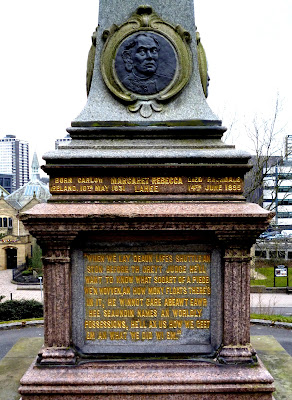Shudehill Bus Station, where there's another example of Lemn Sissay's public poetry, this one titled 'Catching numbers':
Catching numbers
Since the first journey on public transport
– all aboard the womb
first stop The Doctors Arms
To this wonderfully wet
morning in July.
Not even the clumsy age of 16
Was as important as 32
Not even Dad, 40, or Mum, 35,
Was as important as
the number 32.
The thought of the number
32 was the most fantastic thought
of all the thoughtsthat all the thoughts
could think, I thought.
A rainbow sprayed itself across the city
It was 3 minutes to 2.
3 whole minutes to 2
step by step and stop by stop
Tick toc, tick toc.Turning the corner in all its
double decked glory,
A galleon thundered down
the main road
Its captain at the wheel
stern and concentrated.
It growled to a gigantic concrete churning
Kerb rippling road gripping
high street halt.
The closer it got
the smaller I became
Tic toc.
The double decker docked.
Never had I felt more powerful than then
A 16 year old lad stopping
a number 32
A traveller to my dreams and
a passenger to my fate
Not a second too earlynot a minute too late.
Lemn Sissay
ADDENDUM: Lemn Sissay has now won the vote for Chancellor of the University of Manchester. Phew! I'm very pleased to say he easily beat the horrendous Peter Mandelson: we don't want dinosaurs, especially hypocrites like the architect of New Labour!
Links to my other posts of Lemn Sissay public poems are given below:
–––––––––––––––––––––––––––––––––––
The Art of Michael Visocchi and Lemn Sissay in London
Hardys Well and Lemn Sissay's Poem
Lemn Sissay's 'RAIN'




















































